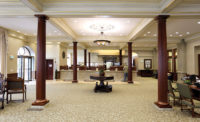
Over the last few years, the American Battle Monuments Commission has organized the establishment of the National World War II Memorial in Washington, DC. The memorial site is located on the National Mall at 17th Street and Constitution Avenue in the nation's capital. Positioned between the Lincoln Memorial and the Washington Monument, the structure has been designed to fit around the existing Rainbow Pool. It features two memorial arches, 56 pillars and a 49-foot freedom wall, all of which have their own symbolic meaning.
The design for the memorial had specific intentions for each element. “It was created as a place to remember the lives that were lost in World War II, and as a tribute to the American war effort,†explained Project Architect Darren Zehner of Leo A Daly in Washington, DC. “The main focal point of the memorial is the ceremonial area where the 'field of stars' is located. On that wall, we have a series of 4,000 gold stars. Each star represents approximately 100 deaths for the 400,000 lives that were lost in World War II. The memorial itself has a series of double column pillars that are set along an elliptically shaped wall, representing the U.S. and its territories. There is a rope between the columns signifying the binding or tying together of the country in a unified effort for the war.â€
In creating such an historic landmark, natural stone was chosen for the primary foundation. More specifically, Kershaw granite was selected as the primary material for its aesthetic appeal, strength, water resistance and durability. “In the design, we went with materials that express longevity,†explained Zehner. “The compressive strength and density of granite is very high, and this particular granite is extremely hard.†New England Stone, LLC, of North Kingston, RI, assisted by three subcontractors provided all of this stone for the Memorial and two buildings. Kershaw granite, which is quarried in South Carolina, was specified for all of the vertical elements of the structure. The blocks of stone were quarried with a combination of drill and wedge, and diamond wire methods. The blocks were then transformed into slabs with the use of gangsaws and diamond wire saws.
Green County granite, which is quarried in Georgia, was chosen for most of the paving stones in the main plaza, which also features a “frame and medallion†design. For this aspect of the paving, 5,000 square feet of Moss Green granite from Brazil was used to comprise the frame, and 2,000 square feet of Rio Verde formed the center medallion. The renovated Rainbow Pool coping was made from Mount Airy granite to match the existing reflecting pool coping.
Overall, the project required a total of 150,000 cubic feet of stone be quarried to produce 94,097 cubic feet and 112,550 square feet of finished material - creating a 384-foot-long, 279-foot-wide national landmark. “All of the blocks of stone are hunks of cubic material, laid on top of each other literally block upon block,†said Zehner. The memorial arches reach up about 45 feet, and are constructed with some of the largest pieces of stone in the structure. They provide a strong base that acts as an anchor for the blocks stacked on top of them. In order to hold the stones together, compression rods and tension rings are being used to secure the pieces.
The memorial arches straddled 250-cubic-foot balcony stones, and the rampart walls were installed beginning at the arches and continuing toward the center.
In creating such a masterpiece, technological limits are being pushed during construction. “Some of the block sizes are reaching close to 100,000 pounds,†said Zehner. The monument consists of 17,644 individual pieces of stone, weighing a total of 15,542,505 pounds.
“We had 50 people working on the project, but 10 stonecutters did the majority of the work,†explained Tony Chiaravalloti of New England Stone Industries. “Our subcontractors had an additional 50 staff members involved. The most challenging aspect of this job was the combination of the quantity, size and complexity of the parts. We developed a 3D solid model of the entire job. We were then able make computer generated templates of each stone.â€
New England Stone's experience with other large-scale projects served them well in fabricating the stonework for the World War II Memorial. “We have done cubic jobs with pieces as big and complex as this job, such as the Pulitzer fountain,†Chiaravalloti explained. “We have also done massive veneer jobs with thousands of pieces, such as 300 Madison Avenue [in New York]. The difference in this job is that it had thousands of large complex cubic pieces.â€
In addition to its experience, the fabricator also relied on advanced technology. “We bought CNC saws to cut this job and they proved to be useful primarily in radial veneer,†Chiaravalloti said. “We used the latest technology in the office and in the plant but skilled stonecutters with traditional saws and hand tools did the vast majority of the work.†The construction of the National World War II Memorial began in September 2001, and is now in its last stages of completion. A dedication is scheduled for this year's Memorial Day weekend, and approximately 3,000,000 people are expected to attend.
End box:
National World War II Memorial, Washington, DC
Architect: Leo A Daly, Washington, DCDesigner: Friedrich St. Florian, Providence, RI
Stone Fabricator: New England Stone, LLC, North Kingston, RI
